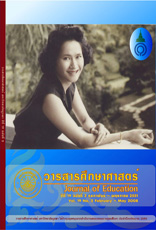การพัฒนาตัวบ่งชี้บทบาทความเป็นมหาวิทยาลัย เพื่อการพัฒนาท้องถิ่น ของมหาวิทยาลัยราชภัฏเพชรบุรี (The Development of Indicators for Local Development Roles of Phetchaburi Rajabhat University)
Keywords:
ตัวบ่งชี้บทบาทเพื่อการพัฒนาท้องถิ่น มหาวิทยาลัยราชภัฏเพชรบุรี, Indicators Local Development Roles Phetchaburi Rajabhat UniversityAbstract
การวิจัยครั้งนี้มีจุดมุ่งหมายเพื่อสร้างและ พัฒนาตัวบ่งชี้บทบาทความเป็นมหาวิทยาลัยเพื่อการพัฒนาท้องถิ่นของมหาวิทยาลัยราชภัฏเพชรบุรี และเพื่อทดสอบความสอดคล้องของโมเดลความสัมพันธ์โครงสร้างเชิงเส้นตัวบ่งชี้บทบาท ความเป็นมหาวิทยาลัยเพื่อการพัฒนาท้องถิ่นของมหาวิทยาลัยราชภัฏเพชรบุรีกับข้อมูลเชิงประจักษ์ กลุ่มตัวอย่างในการวิจัย คือ ผู้บริหารและคณาจารย์ของมหาวิทยาลัยราชภัฏเพชรบุรี จำนวน 261 คน เครื่องมือที่ใช้ในการวิจัยเป็นแบบสอบถามวิเคราะห์ค่าสถิติพื้นฐานโดยใช้โปรแกรม SPSS และใช้โปรแกรม LISREL Version 8.72 ในการวิเคราะห์องค์ประกอบเชิงยืนยัน เพื่อ ทดสอบความสอดคล้องของโมเดลโครงสร้างเชิงเส้นบทบาทความเป็นมหาวิทยาลัยเพื่อการพัฒนา ท้องถิ่นของมหาวิทยาลัยราชภัฏเพชรบุรีกับข้อมูลเชิงประจักษ์ ผลการวิจัย พบว่าองค์ประกอบ หลักทั้ง 7 องค์ประกอบ คือ การจัดการเรียน การสอน การวิจัยการบริการวิชาการ การทำนุบำรุงศิลปวัฒนธรรม การบริหารจัดการ และทรัพยากรเป็นองค์ประกอบสำคัญของบทบาทความเป็นมหาวิทยาลัยเพื่อการพัฒนาท้องถิ่นของมหาวิทยาลัยราชภัฏเพชรบุรี โดยองค์ประกอบที่มีค่าน้ำหนัก องค์ประกอบเรียงลำดับจากมากไปน้อย คือ องค์ประกอบด้านคุณลักษณะของบัณฑิต (.78) องค์ประกอบด้านทรัพยากร (.77) องค์ประกอบ ด้านการบริหารจัดการ (.70) องค์ประกอบ ด้านการวิจัย (.64) องค์ประกอบด้านการทำนุบำรุงศิลปวัฒนธรรม (.64) องค์ประกอบด้าน การบริการวิชาการ (.58) และองค์ประกอบ ด้านการเรียนการสอน (.55) ซึ่งทั้ง 7 องค์ประกอบ หลัก จะต้องปฏิบัติผ่านตัวแปรที่เป็นตัวบ่งชี้บทบาทความ เป็นมหาวิทยาลัยเพื่อการพัฒนา ท้องถิ่น 47 ตัวบ่งชี้ ประกอบด้วย ตัวบ่งชี้ด้าน การเรียนการสอน 10 ตัวบ่งชี้ ด้านการวิจัย 7 ตัวบ่งชี้ ด้านการบริการวิชาการ 6 ตัวบ่งชี้ ด้านการ ทำนุบำรุงศิลปวัฒนธรรม 5 ตัวบ่งชี้ด้านการบริหารจัดการ 7 ตัวบ่งชี้ ด้านคุณลักษณะของบัณฑิต 6 ตัวบ่งชี้ และด้านทรัพยากร 6 ตัวบ่งชี้ ผลการทดสอบความเที่ยงตรงของโมเดล โครงสร้างเชิงเส้นตัวบ่งชี้บทบาทความเป็น มหาวิทยาลัยเพื่อการพัฒนาท้องถิ่นของมหาวิทยาลัย ราชภัฏเพชรบุรี โดยใช้ค่าไค-สแควร์ ค่าดัชนีวัดระดับความกลมกลืนและค่าดัชนีวัดระดับ ความกลมกลืนที่ปรับแก้แล้ว พบว่า โมเดลมีความสอดคล้องกับข้อมูลเชิงประจักษ์อย่างมีนัยสำคัญ ทางสถิติ
Abstract
This research aimed at developing composite indicators for local development roles of Phetchaburi Rajabhat University; to use empirical data to test the validity of the structural medel of local development roles of Phetchaburi Rajabhat University. The research sample consisted of 261 administrators and teachers in Phetchaburi Rajabhat University. The research data were collected by a questionnaire and analyzed by descriptive statistics using SPSS for Windows, confirmatory factor analysis, and second – order confirmatory factor analysis using LISREL Version 8.72 The following conclusions were based on the findings of this research.: The factors which influenced local development roles of Phetchaburi Rajabhat University consisted of seven factors; instruction, research, academic service, art and culture preservation, administration and management, characteristics of graduate, and resources. The composite indicators of local development roles of Phetchaburi Rajabhat University consisted of seven major factors in the order of factor loading as follow : characteristics of graduate (.78), resources (.77), administration and management (.70), research (.64), art and culture preservation (.64), academic service (.58), and instruction (.55). The seven factors must be practiced by 15 (variables which were) minor factors and 47 variables which were the indicators of local development roles. There were 10 indicators of instruction, 7 indicators of research, 6 indicators of academic service, 5 indicators of art and culture preservation, 7 indicators of administration and management, 6 indicators of characteristics, and 6 indicators of resources.
The results of the structural validity test of the model of local development roles of Phetchaburi Rajabhat University with the empirical data by using Chi – square, the Goodness of Fit Index and the Adjusted Goodness of Fit Index revealed that the model significantly correlated with the empirical data.
Downloads
Published
How to Cite
Issue
Section
License
บทความทุกบทความเป็นลิขสิทธิ์ของวารสารศึกษาศาสตร์ มหาวิทยาลัยบูรพา



